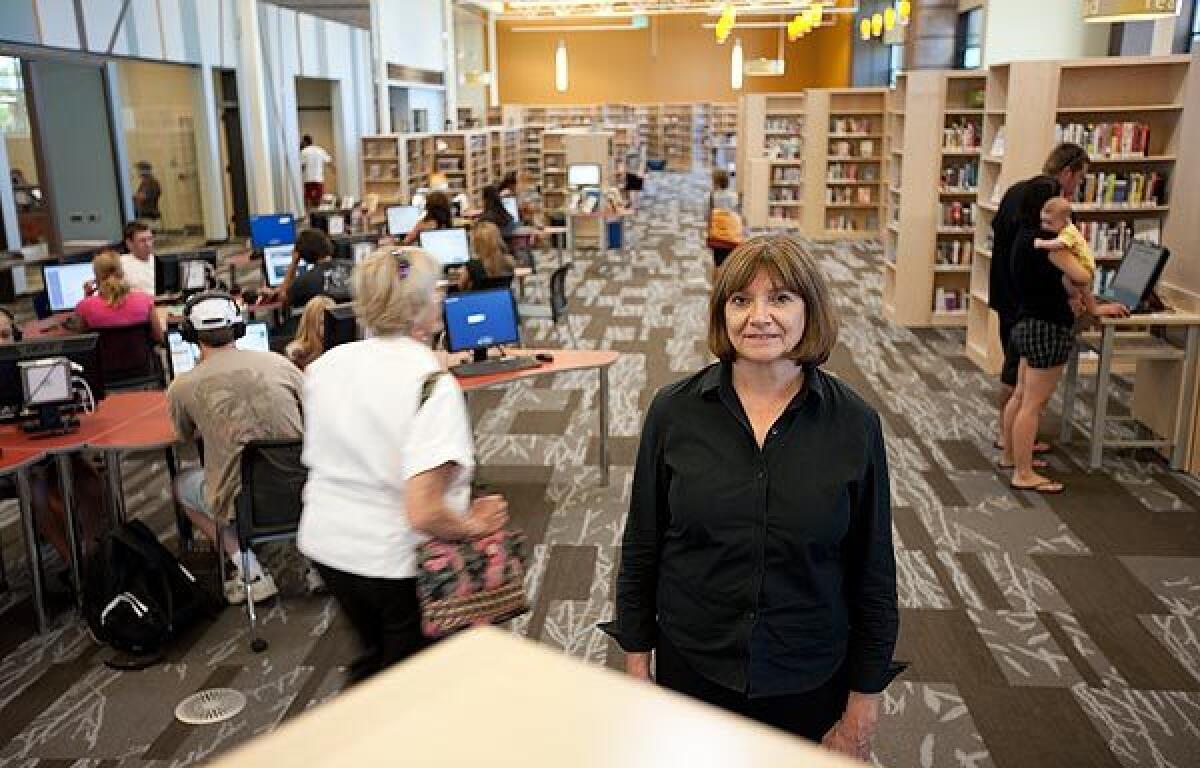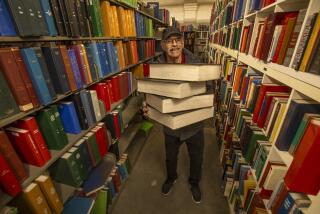Libraries reinvent themselves as they struggle to remain relevant in the digital age

Kathy DeGrego’s T-shirt lets you know right away she isn’t an old-school librarian.
“Shhh,” it says, “is a four-letter word.”
That spirit of bookish defiance has guided the makeover of the suburban Denver library system where DeGrego works. Reference desks and study carrels have been replaced by rooms where kids can play Guitar Hero. Overdue book fines have been eliminated, and the arcane Dewey Decimal System has been scrapped in favor of bookstore-like sections organized by topic.
“It’s very common for people to say, ‘Why do I need a library when I’ve got a computer?’ ” said Pam Sandlian-Smith, director of the seven-branch Rangeview, Colo., Library District. “We have to reframe what the library means to the community.”
In the struggle to stay relevant — and ultimately to stay open — libraries are reinventing themselves in ways unimaginable even a few years ago, preparing for a future in which most materials can be checked and read from a home computer, smart phone or electronic reading device.
University and public libraries are rushing to push as much material as they can onto the Web, so patrons can peruse genealogical records, historical maps or rare volumes without leaving home.
Many public libraries are also becoming digital activity centers, where in addition to books visitors can find game rooms, computer clusters or Internet cafes. Collections of DVDs have swelled, as has the number of high-definition televisions.
Some traditional librarians worry that experiments aimed at making libraries more accessible could dumb them down.
“If you want to have game rooms and pingpong tables and God knows what — poker parties — fine, do it, but don’t pretend it has anything to do with libraries,” said Michael Gorman, a former president of the American Library Assn. “The argument that all these young people would turn up to play video games and think, ‘Oh by the way, I must borrow that book by Dostoyevsky’ — it seems ludicrous to me.”
Others argue that reinvention is a matter of survival in an age when Google Inc. has made the reference desk almost obsolete and printed books are beginning to look more like antique collectibles.
The number of books checked out by the average public library user dropped nearly 6% between 1997 and 2007, according to the Institute of Museum and Library Services. Book checkouts at the New York Public Library alone plunged by 1 million volumes in the most recent fiscal year.
At the 540,000-square-foot Central Library in downtown Los Angeles — the largest public research library west of the Mississippi — few visitors wander the main floors where most of the building’s 2 million books are kept. At wooden reading tables, only a handful of people sit paging through newspapers.
But down the escalator it’s a different story. The 70-seat computer center is often packed as patrons read news, watch YouTube videos and scour the Web for jobs.
In the last fiscal year, the library system’s patrons checked out 102,000 e-books, more than twice as many as in the previous year. The number is on track to nearly double again in 2010.
Like regular books, e-books can be borrowed for a few weeks. Then the book deletes itself from the borrower’s computer, e-reader or mobile phone.
E-book collections at U.S. libraries grew nearly 60% between 2005 and 2008, according to the National Center for Education Statistics. During the same period libraries’ print collections grew less than 1%, though ink-on-paper works still make up 98% of U.S. libraries’ holdings.
Joan Frye Williams, a library consultant and futurist, believes that the underlying purpose of libraries will not change, even if bookshelves disappear.
“Saying that there’s a challenge to libraries because books are changing would be like saying there’s a challenge to family dinner because plates are changing,” she said.
Digital technology is also allowing libraries to digitize large swaths of their collections, creating a virtual library accessible from any computer.
Libraries are leading the effort to scan centuries’ worth of rare, unique and fragile materials as varied as medieval religious manuscripts and antique phone books — whatever they’ve been keeping in the basement.
Libraries are reluctant to digitize new bestsellers and other books still in copyright, or roughly anything published after 1923. But there remains a vast trove of classic books, government documents, historical papers and other material not covered by copyright that libraries can scan without fear of litigation. Many of these digital books and documents can be searched, read and even downloaded free.
“It’s a phenomenal boom,” said Paul LeClerc, president and chief executive of the New York Public Library, which has an online repository of more than 700,000 digital images — including early American maps, photographs, books and historical documents — that attracts visitors from 230 countries every month. “It liberates our collections in a way that would have been inconceivable before.”
Smaller libraries with unique collections are going digital too. At the Conjuring Arts Research Center, a dimly lighted magic library in New York, magician and librarian William Kalush has been working to scan in the entire collection, including 12,000 magic books dating to the 15th century.
“It sounds ridiculous,” he said, “but we want to digitize everything in the magic domain.”
Still, the universal digital library, where users anywhere can access any book, movie or album, is years away.
One hurdle is money. Many public library administrators say they don’t have the funds to make a full-scale conversion to digital books and related equipment, including e-readers that could be lent to patrons.
Piracy concerns have also limited the supply of popular new titles. None of the bestselling “ Harry Potter” books, for example, is available in a digital version. Publishers and some authors are concerned that books, once online, can easily be copied and shared without authorization.
In other cases, such as the new Jonathan Franzen bestseller “Freedom,” the book is available to consumers as an e-book, but the publisher does not offer electronic versions to libraries. The book’s publisher, Farrar, Strauss and Giroux., declined to comment on whether piracy concerns affected its decision to hold the digital version of “Freedom” out of libraries.
Libraries have been building their digital collections by stocking electronic versions of century-old classics not covered by copyright and so-called back-catalog books unlikely to appeal to book pirates, including an array of “how-to” and other nonfiction titles. But when it comes to bestsellers, the digital cupboard is often bare.
“What the libraries are worried about is being sued,” said Peter Jaszi, a professor of copyright law at American University’s Washington College of Law.
Until recently, the threat of a lawsuit by publishers was a “hypothetical concern” for libraries, Jaszi said. Noting that libraries are among the largest purchasers of books and other media, he said, “Generally it’s bad business to sue your best customers.”
That changed in 2008, when a group of publishers, including Cambridge University Press, sued library officials at Georgia State University for making digital copies of course materials, often from copyright-protected library books, available to students. The case is awaiting trial in federal court.
Legal worries have discouraged libraries from making and lending digital copies of many printed books they already own.
A few companies, like OverDrive Inc., offer a service that allows libraries to buy digital copies of some books. Once users download the digital copy to a PC, they have three weeks until the book deletes itself, at which point another patron can download it.
But OverDrive has a limited selection, and because e-books are often wrapped in proprietary software to prevent copying, the company’s books can be read on some electronic readers but not others.
If libraries are mainly staying clear of the uphill battle to change copyright law, Google isn’t. Since 2004, the company has scanned more than 10 million books from dozens of libraries around the world. Many of those books are under copyright, but Google wants to be able to share them anyway, including with libraries.
Publishers and authors initially rejected the idea and in 2005 sued Google for making unauthorized copies. But after three years of litigation, the two sides crafted a settlement that would allow publishers to sell books through Google and give libraries and users instant access to huge numbers of books that have long been out of print but are still legally protected.
The settlement has been opposed by many authors, legal scholars and booksellers, who fear it could give Google too much power over the market for digital books. The 2-year-old pact is under review by a federal court in New York.
Some in the library community worry that libraries could be wiped out by the same technological revolution that threatens video rental, music and book stores, whose wares can now be downloaded in a fraction of the time it takes to drive three blocks and find a parking space.
In response, public libraries in particular are looking to become more like community centers.
At Rangeview in Colorado, visitors can help cultivate the library’s garden, take classes on how to use Facebook or attend “Harry Potter”-themed rock concerts on the library floor.
Alejandra Delacruz, 11, sat in front of a large-screen Apple iMac in the children’s section recently. “I come here twice a week to do my homework,” she said, switching among Facebook, YouTube and a text file with some written notes.
In Charlotte, N.C., the library district built a separate complex, the Imaginon, with digital equipment that children and teens can use to make blue-screen movies, stop-motion animations and rap songs.
Those who spent their childhood reading “Treasure Island” and “Ramona” in a quiet corner of the stacks may resist the idea that libraries could become frenetic workshops. But advocates say equipping libraries with tools for digital creation may be one way to help young people interact with history and literature in a familiar medium.
“That’s how a culture reproduces itself,” said Anne Balsamo, a professor of interactive media at USC. “It doesn’t just make things up willy-nilly, but it also takes time to look back and discover the ways things were done in the past. So yes to rap music and yes to turn-of-the-century poetry.”
ABOUT THIS STORY
This is the third in a series of occasional articles exploring how technology is changing libraries, the publishing industry and the experience of reading. Previous articles, video reviews of e-book readers and e-book applications, and a slide show on the evolution of books are available at https://www.latimes.com /reading.






